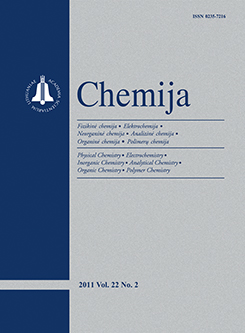 ISSN 0235-7216 ISSN 2424-4538 (online) |
2008 m. Nr. 3-4 Pseudocapacitive behaviour of cobalt oxide films on nano-fibre and magnetron-sputtered substrates
Pseudocapacitance of cobalt (hydro)oxides was studied on parent substrates with different structural properties: nano-fibre structure, magnetron-sputtered and mechanically treated. The nano-fibred structure was formed electrochemically from an alkaline plating solution. The pseudocapacitive behaviour of the samples was studied by cyclic voltammetry in conjunction with the electrochemical quartz crystal nano-balance technique. (Hydro)oxide layers were formed on the substrates by anodic polarization. The layers exhibited a reversible reduction-reoxidation behaviour with the corresponding pseudocapacitive behaviour. The nano-gravimetric measurements indicated a distinct electrode mass growth during the first anodic polarization scan, while the mass actually did not change during the reversible potential scan. The oxide layer stability was demonstrated by applying polarization cycles in the order of several thousand. The charge capacity for the nano-fibre sample was found to be up to 5 times higher as compared to a conventional cobalt surface (mechanically abraded). EQCM data have shown that the electrochemical charge transfer reactions Co(II) ↔ Co(III) ↔ Co(IV) are not associated with a remarkable electrode mass change. A novel in-situ approach was proposed to evaluate pseudocapacitive performance by measuring the charge value per one mass unit of oxygen (O2–) within the oxide structure. Keywords: cobalt oxide, pseudocapacitance, nanostructure, EQCM, supercapacitors |
Issues:
2017 - Vol.28 No. 1, No. 2, No. 3, No. 4 2016 - Vol.27 No. 1, No. 2, No. 3, No. 4 2015 - Vol.26 No. 1, No. 2, No. 3, No. 4 2014 - Vol.25 No. 1, No. 2, No. 3, No. 4 2013 - Vol.24 No. 1, No. 2, No. 3, No. 4 2012 - Vol.23 No. 1, No. 2, No. 3, No. 4 2011 - Vol.22 No. 1, No. 2, No. 3, No. 4 2010 - Vol.21 No. 1, No. 2-4 2009 - Vol.20 No. 1, No. 2, No. 3, No. 4 2008 - Vol.19 No. 1, No. 2, No. 3-4 2007 - Vol.18 No. 1, No. 2, No. 3, No. 4 2006 - Vol.17 No. 1, No. 2-3, No. 4 2005 - Vol.16 No. 1, No. 2, No. 3-4 2004 - Vol.15 No. 1, No. 2, No. 3, No. 4 2003 - Vol.14 No. 1, No. 2, No. 3, No. 4 2002 - Vol.13 No. 1, No. 2, No. 3, No. 4 2001 - Vol.12 No. 1, No. 2, No. 3, No. 4 |